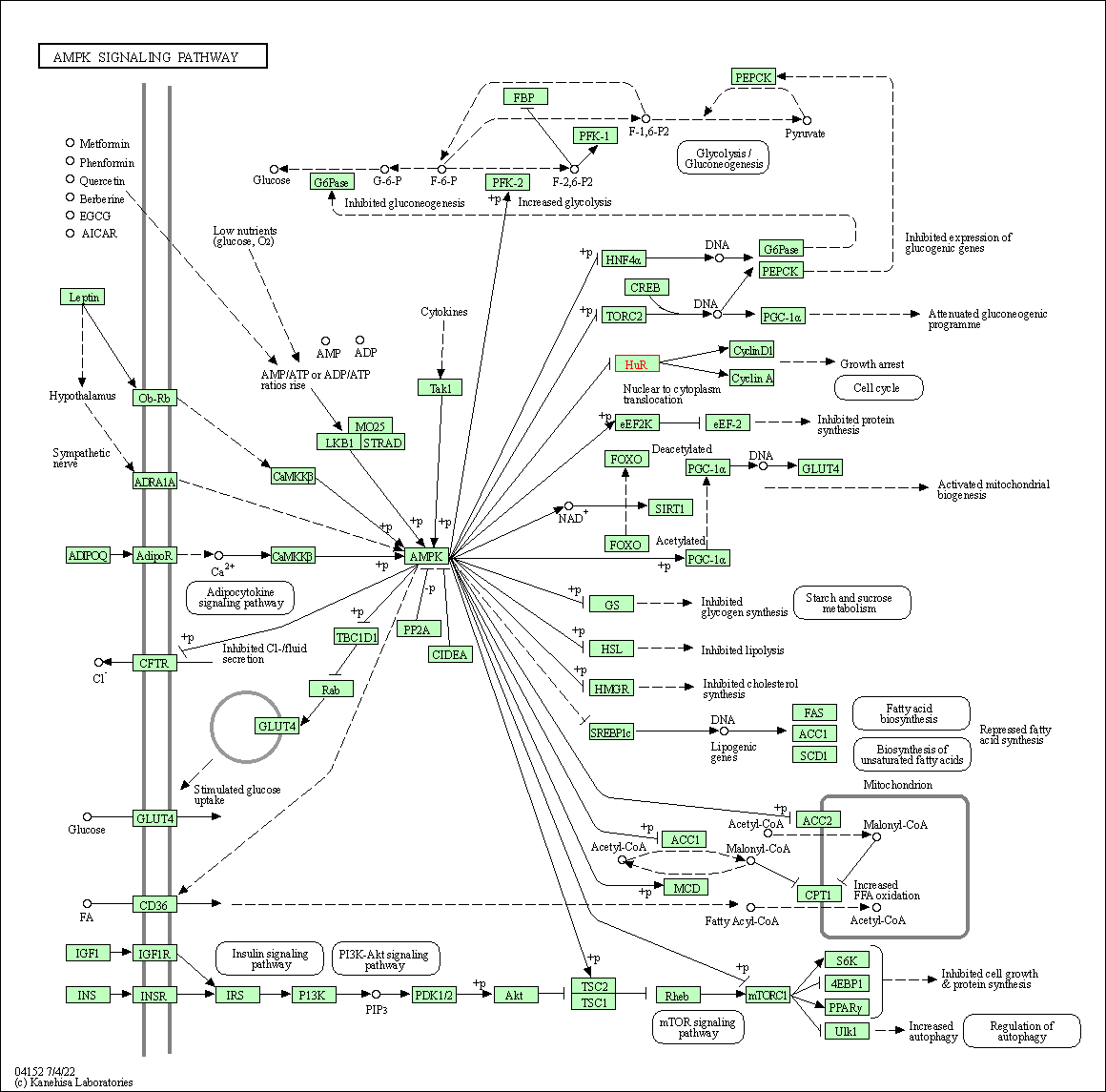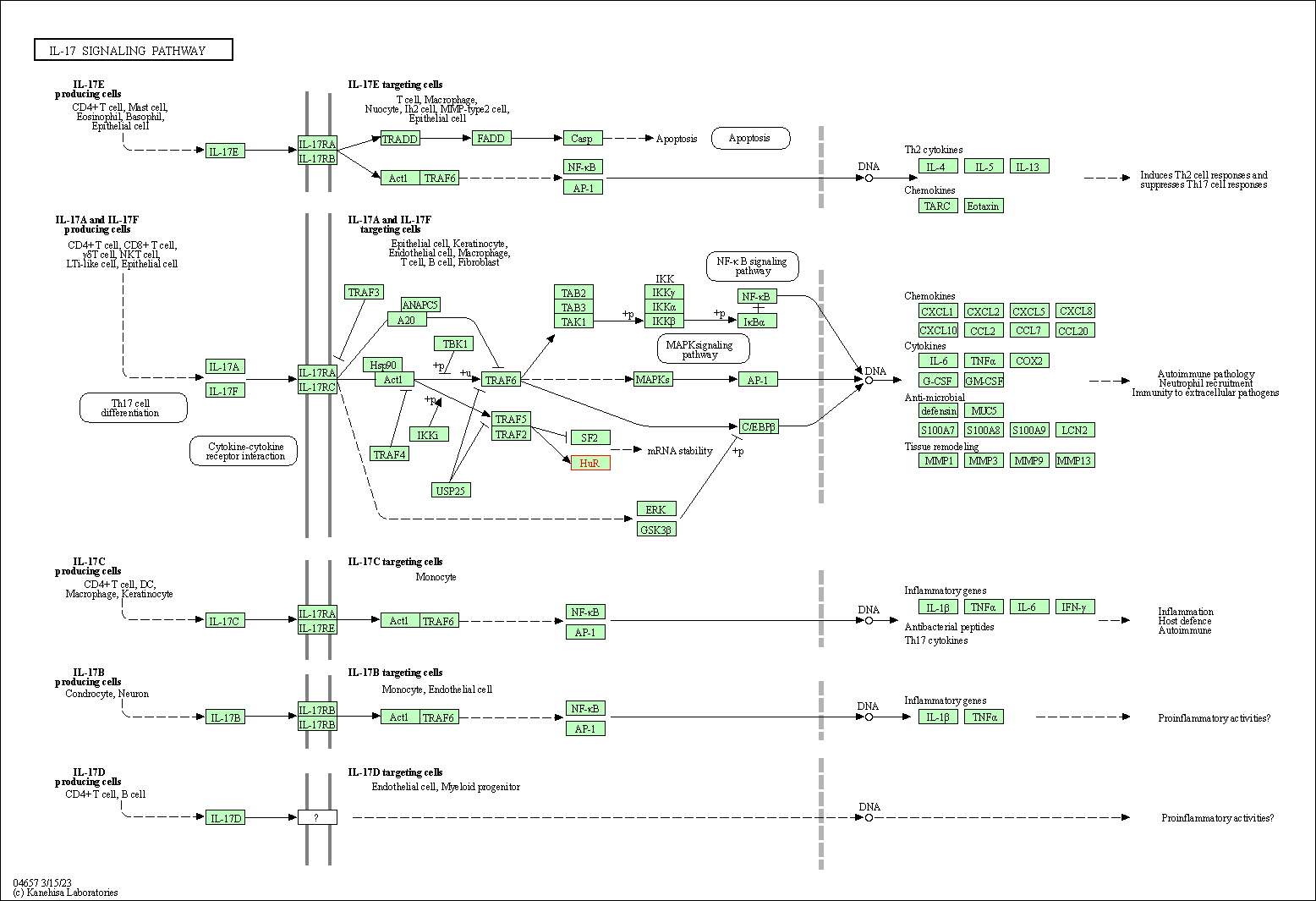Target Information
| Target General Information | Top | |||||
|---|---|---|---|---|---|---|
| Target ID |
T78349
(Former ID: TTDR00841)
|
|||||
| Target Name |
ELAV-like protein 1 (ELAVL1)
|
|||||
| Synonyms |
HuR; Hu-antigen R
Click to Show/Hide
|
|||||
| Gene Name |
ELAVL1
|
|||||
| Target Type |
Literature-reported target
|
[1] | ||||
| Function |
Involved in embryonic stem cells (ESCs) differentiation: preferentially binds mRNAs that are not methylated by N6-methyladenosine (m6A), stabilizing them, promoting ESCs differentiation. Binds to poly-U elements and AU-rich elements (AREs) in the 3'-UTR of target mRNAs. Binds avidly to the AU-rich element in FOS and IL3/interleukin-3 mRNAs. In the case of the FOS AU-rich element, binds to a core element of 27 nucleotides that contain AUUUA, AUUUUA, and AUUUUUA motifs. Binds preferentially to the 5'-UUUU[AG]UUU-3' motif in vitro. With ZNF385A, binds the 3'-UTR of p53/TP53 mRNA to control their nuclear export induced by CDKN2A. Hence, may regulate p53/TP53 expression and mediate in part the CDKN2A anti-proliferative activity. May also bind with ZNF385A the CCNB1 mRNA. Increases the stability of the leptin mRNA harboring an AU-rich element (ARE) in its 3' UTR. RNA-binding protein that binds to the 3'-UTR region of mRNAs and increases their stability.
Click to Show/Hide
|
|||||
| UniProt ID | ||||||
| Sequence |
MSNGYEDHMAEDCRGDIGRTNLIVNYLPQNMTQDELRSLFSSIGEVESAKLIRDKVAGHS
LGYGFVNYVTAKDAERAINTLNGLRLQSKTIKVSYARPSSEVIKDANLYISGLPRTMTQK DVEDMFSRFGRIINSRVLVDQTTGLSRGVAFIRFDKRSEAEEAITSFNGHKPPGSSEPIT VKFAANPNQNKNVALLSQLYHSPARRFGGPVHHQAQRFRFSPMGVDHMSGLSGVNVPGNA SSGWCIFIYNLGQDADEGILWQMFGPFGAVTNVKVIRDFNTNKCKGFGFVTMTNYEEAAM AIASLNGYRLGDKILQVSFKTNKSHK Click to Show/Hide
|
|||||
| 3D Structure | Click to Show 3D Structure of This Target | AlphaFold | ||||
| HIT2.0 ID | T16A8U | |||||
| Cell-based Target Expression Variations | Top | |||||
|---|---|---|---|---|---|---|
| Cell-based Target Expression Variations | ||||||
| Drug Binding Sites of Target | Top | |||||
|---|---|---|---|---|---|---|
| Ligand Name: Diglyme | Ligand Info | |||||
| Structure Description | Crystal structure of the two N-terminal RRM domains of HuR complexed with RNA | PDB:4ED5 | ||||
| Method | X-ray diffraction | Resolution | 2.00 Å | Mutation | No | [2] |
| PDB Sequence |
GRTNLIVNYL
27 PQNMTQDELR37 SLFSSIGEVE47 SAKLIRDKVA57 GHSLGYGFVN67 YVTAKDAERA 77 INTLNGLRLQ87 SKTIKVSYAR97 PSSEVIKDAN107 LYISGLPRTM117 TQKDVEDMFS 127 RFGRIINSRV137 LVDQTTGLSR147 GVAFIRFDKR157 SEAEEAITSF167 NGHKPPGSSE 177 PITVKFAA
|
|||||
|
|
||||||
| Click to View More Binding Site Information of This Target with Different Ligands | ||||||
| Different Human System Profiles of Target | Top |
|---|---|
|
Human Similarity Proteins
of target is determined by comparing the sequence similarity of all human proteins with the target based on BLAST. The similarity proteins for a target are defined as the proteins with E-value < 0.005 and outside the protein families of the target.
A target that has fewer human similarity proteins outside its family is commonly regarded to possess a greater capacity to avoid undesired interactions and thus increase the possibility of finding successful drugs
(Brief Bioinform, 21: 649-662, 2020).
Human Tissue Distribution
of target is determined from a proteomics study that quantified more than 12,000 genes across 32 normal human tissues. Tissue Specificity (TS) score was used to define the enrichment of target across tissues.
The distribution of targets among different tissues or organs need to be taken into consideration when assessing the target druggability, as it is generally accepted that the wider the target distribution, the greater the concern over potential adverse effects
(Nat Rev Drug Discov, 20: 64-81, 2021).
Human Pathway Affiliation
of target is determined by the life-essential pathways provided on KEGG database. The target-affiliated pathways were defined based on the following two criteria (a) the pathways of the studied target should be life-essential for both healthy individuals and patients, and (b) the studied target should occupy an upstream position in the pathways and therefore had the ability to regulate biological function.
Targets involved in a fewer pathways have greater likelihood to be successfully developed, while those associated with more human pathways increase the chance of undesirable interferences with other human processes
(Pharmacol Rev, 58: 259-279, 2006).
Biological Network Descriptors
of target is determined based on a human protein-protein interactions (PPI) network consisting of 9,309 proteins and 52,713 PPIs, which were with a high confidence score of ≥ 0.95 collected from STRING database.
The network properties of targets based on protein-protein interactions (PPIs) have been widely adopted for the assessment of target’s druggability. Proteins with high node degree tend to have a high impact on network function through multiple interactions, while proteins with high betweenness centrality are regarded to be central for communication in interaction networks and regulate the flow of signaling information
(Front Pharmacol, 9, 1245, 2018;
Curr Opin Struct Biol. 44:134-142, 2017).
Human Similarity Proteins
Human Tissue Distribution
Human Pathway Affiliation
Biological Network Descriptors
|
|
|
There is no similarity protein (E value < 0.005) for this target
|
|
Note:
If a protein has TS (tissue specficity) scores at least in one tissue >= 2.5, this protein is called tissue-enriched (including tissue-enriched-but-not-specific and tissue-specific). In the plots, the vertical lines are at thresholds 2.5 and 4.
|


| KEGG Pathway | Pathway ID | Affiliated Target | Pathway Map |
|---|---|---|---|
| AMPK signaling pathway | hsa04152 | Affiliated Target |

|
| Class: Environmental Information Processing => Signal transduction | Pathway Hierarchy | ||
| IL-17 signaling pathway | hsa04657 | Affiliated Target |

|
| Class: Organismal Systems => Immune system | Pathway Hierarchy | ||
| Degree | 33 | Degree centrality | 3.55E-03 | Betweenness centrality | 1.99E-03 |
|---|---|---|---|---|---|
| Closeness centrality | 2.27E-01 | Radiality | 1.40E+01 | Clustering coefficient | 3.41E-01 |
| Neighborhood connectivity | 3.06E+01 | Topological coefficient | 9.43E-02 | Eccentricity | 12 |
| Download | Click to Download the Full PPI Network of This Target | ||||
| Chemical Structure based Activity Landscape of Target | Top |
|---|---|
| Target Poor or Non Binders | Top | |||||
|---|---|---|---|---|---|---|
| Target Poor or Non Binders | ||||||
| Target Regulators | Top | |||||
|---|---|---|---|---|---|---|
| Target-regulating microRNAs | ||||||
| Target-interacting Proteins | ||||||
| References | Top | |||||
|---|---|---|---|---|---|---|
| REF 1 | HuR, a novel target of anti-Hu antibodies, is expressed in non-neural tissues. J Neuroimmunol. 1998 Dec 1;92(1-2):152-9. | |||||
| REF 2 | The structure of the ARE-binding domains of Hu antigen R (HuR) undergoes conformational changes during RNA binding. Acta Crystallogr D Biol Crystallogr. 2013 Mar;69(Pt 3):373-80. | |||||
If You Find Any Error in Data or Bug in Web Service, Please Kindly Report It to Dr. Zhou and Dr. Zhang.

